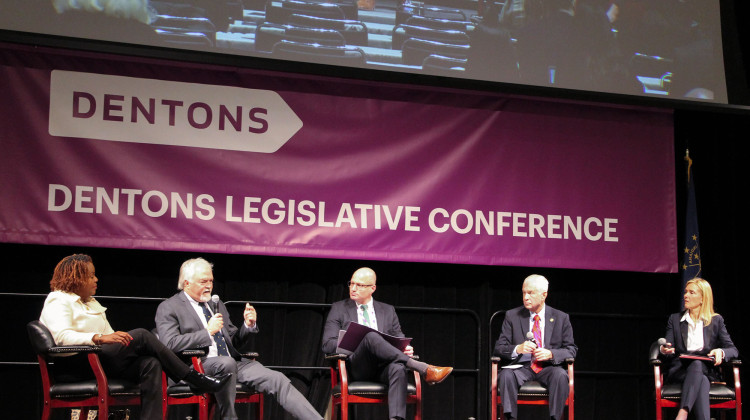
Covering Kids and Families policy director Mark Fairchild, right, answers a text question on how to predict the cost of a single-payer health care system at Damsel Brew Pub in Evansville during an Issues & Ales conversation.
Lauren Chapman/IPB NewsMembers of our Indiana 2020 Two-Way texting group told us they wanted to know more about health care costs, what’s being done to address them, and why the system is the way it is.
So, Indiana Public Broadcasting, Side Effects Public Media and WNIN went to work to answer some of those questions – including at a live event in Evansville. We gathered health care experts to answer some of your questions, including: Claudia Eisenmann, president and CEO of Gibson General Hospital; Mark Fairchild, policy director for Covering Kids and Families Indiana; and Ammer Williams, lead health care navigator at Covering Kids and Families Tri-Cap.
Billing is very confusing, and it’s hard to know what things cost. Many times, the same visit and procedure is billed differently.
Federally and at the Indiana Statehouse, measures are moving through the legislative process to tackle medical billing transparency.
“Even if I still was going to get that bill, I wanted to know that bill was coming – and how to deal with it and be prepared for it ahead of time,” Fairchild says. “Or make different choices if that bill was something I wasn’t going to be able to afford.”
Indiana lawmakers are tackling this issue in two main ways: through an all-payer claims database and a bill that sets up protections against surprise health care billing.
The bill establishing surprise billing protections would prevent out-of-network billing for emergency services, and allow patients to request a good faith estimate for procedures five days ahead of an appointment.
The database would aggregate the costs of procedures at specific hospitals and health care providers, allowing consumers to make informed health care choices.
A different listener reached out to ask about the practicality of the database for rural Hoosiers. They said the idea that people can shop around and compare prices isn’t practical in rural counties.
Eisenmann runs a rural hospital. She says to stay in rural communities, hospitals have had to get into the business of employing doctors, which means taking on a greater financial burden.
Just last year, Eisenmann says her hospital spent $4.3 million on upgrading electronic medical records to get all the hospital’s physicians on the same system.
“There are many many costs, I think, in health care that people just don’t understand. And if I didn’t work in health care, I wouldn’t understand them either,” Eisenmann says.
She says to keep physicians in rural communities and to improve the health of those communities, those costs are necessary. Eisenmann also says it’s important to remember that there isn’t standardized pricing in health care.
For many of us who have been engaging with the American health care system since the ’70s and ’80s, there’s always the question of how costs have risen so astronomically and why has insurance become so personally expensive, yet covers less and less of those astronomical costs?
Eisenmann says the health care system tried to change in the 1980s, when the government system went from paying bill charges to a “prospectively paid” system. She says the government created diagnostic-related groups. If someone came to the hospital with a specific diagnosis, the government was going to pay the hospital a specific amount of money, regardless of other conditions or length of hospital stay.
The idea was to reduce costs. But Eisenmann says that was the point government payments to hospitals were reduced.
“So, government payments kind of start going down at that time. But you had an entire system that was built around a different payment methodology,” Eisenmann says. “So, things began to shift more over to insurance companies and the like. Payments started getting modified across the board. Individuals started picking up a bigger share of insurance through co-pays and deductibles and this kind of thing – we’ve seen that continue to escalate in recent years.”
Eisenmann also points to Indiana’s health outcomes as well. She says the state, and country as a whole, is unhealthier – including in key metrics in the state like smoking, obesity, diabetes and vaccination rates.
READ MORE: In Your Words: Healthcare Is Too Expensive and Confusing
I get my insurance through the marketplace, and it went up $129 a month. Why does it go up every year, even though the plan hasn’t changed?
There are a lot of things that impact the marketplace. Fairchild says a common misconception is that the marketplace is very controlled – instead it’s just as fluid as any other insurance market.
Political uncertainty has been a big factor in the price changes to the marketplace: insurance companies didn’t know if the subsidies they got from the exchange were going to continue, so they increased the cost of their premiums.
Additionally, 50- to 64-year-olds can be charged up to three times as much as someone who is younger and assumed to be healthier. And changes in individual income can change premiums.
“The positive note is, last year was probably the most stable year we’ve seen in the marketplace for this year’s marketplace,” Fairchild says. “Indiana stayed pretty flat, 3-5 percent different from the year before, which is about the flattest we’ve seen. Nationwide, it was at even a tighter margin than that. So we’re seeing some stability.”
Would increased taxes to fund a single-pay model health care system, be greater or less than the average yearly premium cost?
Fairchild says there wouldn’t be a way to fund that kind of system without a tax hit – but, whether it would be more or less is kind of all over the place.
“We really aren’t good at anticipating that, so it’s hard to get an idea of that,” Fairchild says. “If we look at the Affordable Care Act, for one example, it ended up being – for most people – a higher price tag than they were thinking. Especially if you’re not in that realm where you’re getting your plan subsidized.”
Why? Fairchild says it’s because we assumed more young adults would join the marketplace, bringing the risk down. The people who ended up joining needed access to insurance because of pre-existing conditions.
But there are so many variables – like how the health care system would adapt to the government, how many people joined the insurance pool – it’s too difficult to predict.
When you’re an in-patient, with multiple services following you, it’s impossible to keep track of which doctor is in-network and which is not. I think most people make sure the hospital is in-network, but the consumer needs to know about the individual doctors, the pharmacy, the therapist, etc.
Fairchild says Indiana lawmakers are working on precisely this problem. A bill to address surprise health care billing would protect against getting billed for out-of-network costs if the health care facility is in network.
“There’s a good cluster of bills that's saying, if I’m in the building and I’m in-network, and I know it’s in-network, if I go down the hall, I shouldn’t have to pay anything more than the same co-payments if it were in-network,” Fairchild says. “And if that’s going to vary, you need to give me notice of that. So I at least have the choice to make to say, gee, I could go to the facility down the road instead of down the hall and save $1,000 – I’ll make that choice.”
The same bill also provides protections for emergency room care.
Join the conversation! Text "elections" to 73224 to join the Indiana 2020 Two-Way. What issues do you want to see covered ahead of the 2020 election? Every other week, we'll send you a text message on a different topic. Your responses turn into larger conversations like this and stories from our statewide team of reporters.
 DONATE
DONATE





 View More Programs
View More Programs





 Support WFYI. We can't do it without you.
Support WFYI. We can't do it without you.